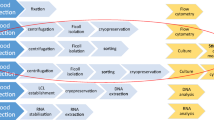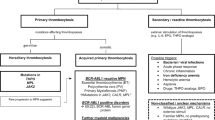Abstract
Thromboembolic events including cerebral thrombosis, deep vein thrombosis, and pulmonary embolism are major complications in β-thalassemia. Damaged red blood cells and chronic platelet activation in splenectomized β-thalassemia/HbE patients were associated with increased microparticles (MPs) releases into blood circulation. MPs are small membrane vesicles, which play important roles on coagulation. However, the role of MP in thalassemia is poorly understood. In this study, the effects of splenectomized-MPs on platelet activation and aggregation were investigated. The results showed that isolated MPs from fresh platelet-free plasma of patients and normal subjects directly induce platelet activation, platelet aggregation, and platelet-neutrophil aggregation in a dose-dependent manner. Interestingly, MPs obtained from splenectomized patients are more efficient in induction of platelet activation (P-selectin+) when compared to MPs from normal subjects (P < 0.05), tenfold lower than pathophysiological level, at 1:0.1 platelet MP ratio. Co-incubation of splenectomized-MPs with either normal-, non-splenectomized- or splenectomized-platelets at 1:10 platelet MP ratio increased platelet activation up to 5.1 ± 2.2, 5.6 ± 3.7, and 9.5 ± 3.0%, respectively, when normalized with individual baseline. These findings suggest that splenectomized patients were proned to be activated by MPs, and splenectomized-MPs could play an important role on chronic platelet activation and aggregation, leading to thrombus formation in β-thalassemia/HbE patients.




Similar content being viewed by others
Abbreviations
- MPs:
-
microparticles
- PPP:
-
platelet-poor plasma
- PRP:
-
platelet-rich plasma
- PS:
-
phosphatidylserine
- PSGL-1:
-
P-selectin glycoprotein ligand-1
References
Burnier L, Fontana P, Kwak BR, Angelillo-Scherrer A (2009) Cell-derived microparticles in haemostasis and vascular medicine. Thromb Haemost 101(3):439–451
Freyssinet JM, Toti F (2010) Formation of procoagulant microparticles and properties. Thromb Res 125(Suppl 1):S46–S48. doi:10.1016/j.thromres.2010.01.036
Rak J (2010) Microparticles in cancer. Semin Thromb Hemost 36(8):888–906. doi:10.1055/s-0030-1267043
Horstman LL, Ahn YS (1999) Platelet microparticles: a wide-angle perspective. Crit Rev Oncol Hematol 30(2):111–142
Berckmans RJ, Nieuwland R, Boing AN, Romijn FP, Hack CE, Sturk A (2001) Cell-derived microparticles circulate in healthy humans and support low grade thrombin generation. Thromb Haemost 85(4):639–646
Piccin A, Murphy WG, Smith OP (2007) Circulating microparticles: pathophysiology and clinical implications. Blood Rev 21(3):157–171. doi:10.1016/j.blre.2006.09.001
Simak J, Gelderman MP (2006) Cell membrane microparticles in blood and blood products: potentially pathogenic agents and diagnostic markers. Transfus Med Rev 20(1):1–26. doi:10.1016/j.tmrv.2005.08.001
van Beers EJ, Schaap MC, Berckmans RJ, Nieuwland R, Sturk A, van Doormaal FF, Meijers JC, Biemond BJ (2009) Circulating erythrocyte-derived microparticles are associated with coagulation activation in sickle cell disease. Haematologica 94(11):1513–1519. doi:10.3324/haematol.2009.008938
Tomer A, Harker LA, Kasey S, Eckman JR (2001) Thrombogenesis in sickle cell disease. J Lab Clin Med 137(6):398–407. doi:10.1067/mlc.2001.115450
Pattanapanyasat K, Noulsri E, Fucharoen S, Lerdwana S, Lamchiagdhase P, Siritanaratkul N, Webster HK (2004) Flow cytometric quantitation of red blood cell vesicles in thalassemia. Cytometry B Clin Cytom 57(1):23–31. doi:10.1002/cyto.b.10064
Westerman M, Pizzey A, Hirschman J, Cerino M, Weil-Weiner Y, Ramotar P, Eze A, Lawrie A, Purdy G, Mackie I, Porter J (2008) Microvesicles in haemoglobinopathies offer insights into mechanisms of hypercoagulability, haemolysis and the effects of therapy. Br J Haematol 142(1):126–135. doi:10.1111/j.1365-2141.2008.07155.x
Habib A, Kunzelmann C, Shamseddeen W, Zobairi F, Freyssinet JM, Taher A (2008) Elevated levels of circulating procoagulant microparticles in patients with beta-thalassemia intermedia. Haematologica 93(6):941–942. doi:10.3324/haematol.12460
Pattanapanyasat K, Gonwong S, Chaichompoo P, Noulsri E, Lerdwana S, Sukapirom K, Siritanaratkul N, Fucharoen S (2007) Activated platelet-derived microparticles in thalassaemia. Br J Haematol 136(3):462–471
Chaichompoo P, Kumya P, Khowawisetsut L, Chiangjong W, Chaiyarit S, Pongsakul N, Sirithanaratanakul N, Fucharoen S, Thongboonkerd V, Pattanapanyasat K (2012) Characterizations and proteome analysis of platelet-free plasma-derived microparticles in beta-thalassemia/hemoglobin E patients. J Proteome 76 :239–250. doi:10.1016/j.jprot.2012.06.004Spec No
Ruggeri ZM (2002) Platelets in atherothrombosis. Nat Med 8(11):1227–1234. doi:10.1038/nm1102-1227
Joseph M (1995) The generation of free radicals by blood platelets. Immunopharmacology of platelets. In. Academic Press, San Diego, pp. 209–223
Michelson AD (2003) How platelets work: platelet function and dysfunction. J Thromb Thrombolysis 16(1–2):7–12. doi:10.1023/b:thro.0000014586.77684.82
Furie B, Furie BC, Flaumenhaft R (2001) A journey with platelet P-selectin: the molecular basis of granule secretion, signalling and cell adhesion. Thromb Haemost 86(1):214–221
Furman MI, Barnard MR, Krueger LA, Fox ML, Shilale EA, Lessard DM, Marchese P, Frelinger AL 3rd, Goldberg RJ, Michelson AD (2001) Circulating monocyte-platelet aggregates are an early marker of acute myocardial infarction. J Am Coll Cardiol 38(4):1002–1006
Gawaz M, Neumann FJ, Ott I, Schiessler A, Schomig A (1996) Platelet function in acute myocardial infarction treated with direct angioplasty. Circulation 93(2):229–237
Marquardt L, Ruf A, Mansmann U, Winter R, Schuler M, Buggle F, Mayer H, Grau AJ (2002) Course of platelet activation markers after ischemic stroke. Stroke; a journal of cerebral circulation 33(11):2570–2574
Keawvichit R, Khowawisetsut L, Chaichompoo P, Polsrila K, Sukklad S, Sukapirom K, Khuhapinant A, Fucharoen S, Pattanapanyasat K (2012) Platelet activation and platelet-leukocyte interaction in beta-thalassemia/hemoglobin E patients with marked nucleated erythrocytosis. Ann Hematol 91(11):1685–1694. doi:10.1007/s00277-012-1522-2
Srihirun S, Tanjararak N, Chuncharunee S, Sritara P, Kaewvichit R, Fucharoen S, Pattanapanyasat K, Sibmooh N (2015) Platelet hyperactivity in thalassemia patients with elevated tricuspid regurgitant velocity and the association with hemolysis. Thromb Res 135(1):121–126. doi:10.1016/j.thromres.2014.10.010
Taher AT, Musallam KM, Karimi M, El-Beshlawy A, Belhoul K, Daar S, Saned M, Cesaretti C, Cappellini MD (2010) Splenectomy and thrombosis: the case of thalassemia intermedia. Journal of thrombosis and haemostasis : JTH 8(10):2152–2158. doi:10.1111/j.1538-7836.2010.03940.x
Mause SF, Weber C (2010) Microparticles: protagonists of a novel communication network for intercellular information exchange. Circ Res 107(9):1047–1057. doi:10.1161/circresaha.110.226456
Montoro-Garcia S, Shantsila E, Marin F, Blann A, Lip GY (2011) Circulating microparticles: new insights into the biochemical basis of microparticle release and activity. Basic Res Cardiol 106(6):911–923. doi:10.1007/s00395-011-0198-4
Musallam KM, Taher AT, Karimi M, Rachmilewitz EA (2012) Cerebral infarction in beta-thalassemia intermedia: breaking the silence. Thromb Res 130(5):695–702. doi:10.1016/j.thromres.2012.07.013
Taher A, Isma'eel H, Mehio G, Bignamini D, Kattamis A, Rachmilewitz EA, Cappellini MD (2006) Prevalence of thromboembolic events among 8,860 patients with thalassaemia major and intermedia in the Mediterranean area and Iran. Thromb Haemost 96(4):488–491
Eldor A, Rachmilewitz EA (2002) The hypercoagulable state in thalassemia. Blood 99(1):36–43
Atichartakarn V, Angchaisuksiri P, Aryurachai K, Onpun S, Chuncharunee S, Thakkinstian A, Atamasirikul K (2002) Relationship between hypercoagulable state and erythrocyte phosphatidylserine exposure in splenectomized haemoglobin E/beta-thalassaemic patients. Br J Haematol 118(3):893–898
Forlow SB, McEver RP, Nollert MU (2000) Leukocyte-leukocyte interactions mediated by platelet microparticles under flow. Blood 95(4):1317–1323
Gao Y, Lv L, Liu S, Ma G, Su Y (2013) Elevated levels of thrombin-generating microparticles in stored red blood cells. Vox Sang 105(1):11–17. doi:10.1111/vox.12014
Donadee C, Raat NJ, Kanias T, Tejero J, Lee JS, Kelley EE, Zhao X, Liu C, Reynolds H, Azarov I, Frizzell S, Meyer EM, Donnenberg AD, Qu L, Triulzi D, Kim-Shapiro DB, Gladwin MT (2011) Nitric oxide scavenging by red blood cell microparticles and cell-free hemoglobin as a mechanism for the red cell storage lesion. Circulation 124(4):465–476. doi:10.1161/CIRCULATIONAHA.110.008698
Acknowledgements
This work was supported by Faculty of Science, Mahidol University; Faculty of Science and Faculty of Medicine Ramathibodi Hospital, Mahidol University; Mahidol University Research Grants; Office of the Higher Education Commission and Mahidol University under the National Research University Initiative; Thailand Research Fund (TRF) (IRG5780009); The TRF Distinguished Research Professor Grant (DPG5980001); The Royal Golden Jubilee PhD Program of TRF; and Research Chair Grant, National Science and Technology Development Agency, Thailand. PK was supported under the Royal Golden Jubilee PhD Program of TRF.
Authors’ contributions
PK, KPh, and WK performed the experiments and analyzed the data. EN and NPM contributed to the concept of the study and interpretation. AK and SF contributed to the concept of the study and specimen collection. SS contributed to the concept of the study, design the experiments, the analysis of the data, and drafting the manuscript. KPa and PC were the principal investigator and take primary responsibility for the concept and design of the project, the analysis of the data, and drafting the manuscript. All authors reviewed and approved the final version to be published.
Author information
Authors and Affiliations
Corresponding authors
Ethics declarations
Funding
This work was supported by Faculty of Science, Mahidol University; Faculty of Science and Faculty of Medicine Ramathibodi Hospital, Mahidol University; Mahidol University Research Grants; Office of the Higher Education Commission and Mahidol University under the National Research University Initiative; Thailand Research Fund (TRF) (IRG5780009); The TRF Distinguished Research Professor Grant (DPG5980001); The Royal Golden Jubilee Program of TRF; and Research Chair Grant, National Science and Technology Development Agency, Thailand.
Conflict of interest
The authors declare that they have no conflict of interest.
Redundant publication
No substantial overlap with previous papers.
Additional information
Phatchanat Klaihmon and Kunwadee Phongpao contributed equally to this work.
Rights and permissions
About this article
Cite this article
Klaihmon, P., Phongpao, K., Kheansaard, W. et al. Microparticles from splenectomized β-thalassemia/HbE patients play roles on procoagulant activities with thrombotic potential. Ann Hematol 96, 189–198 (2017). https://doi.org/10.1007/s00277-016-2885-6
Received:
Accepted:
Published:
Issue Date:
DOI: https://doi.org/10.1007/s00277-016-2885-6




